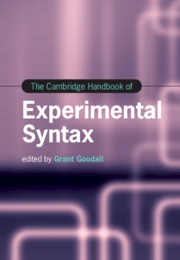Book contents
- The Cambridge Handbook of Experimental Syntax
- The Cambridge Handbook of Experimental Syntax
- Copyright page
- Contents
- Figures
- Tables
- Contributors
- Introduction
- Part I General Issues in Acceptability Experiments
- Part II Experimental Studies of Specific Phenomena
- 8 Resumptive Pronouns in English
- 9 Island Effects
- 10 The That-Trace Effect
- 11 Anaphora: Experimental Methods for Investigating Coreference
- 12 Constituent Order and Acceptability
- 13 Acceptability Judgments at the Syntax–Semantics Interface
- Part III Experimental Studies of Specific Populations and Language Families
- Part IV Experimental Syntax beyond Acceptability
- Index
- References
10 - The That-Trace Effect
from Part II - Experimental Studies of Specific Phenomena
Published online by Cambridge University Press: 16 December 2021
- The Cambridge Handbook of Experimental Syntax
- The Cambridge Handbook of Experimental Syntax
- Copyright page
- Contents
- Figures
- Tables
- Contributors
- Introduction
- Part I General Issues in Acceptability Experiments
- Part II Experimental Studies of Specific Phenomena
- 8 Resumptive Pronouns in English
- 9 Island Effects
- 10 The That-Trace Effect
- 11 Anaphora: Experimental Methods for Investigating Coreference
- 12 Constituent Order and Acceptability
- 13 Acceptability Judgments at the Syntax–Semantics Interface
- Part III Experimental Studies of Specific Populations and Language Families
- Part IV Experimental Syntax beyond Acceptability
- Index
- References
Summary
The that-trace effect is one of several long-distance extraction phenomena that have been the focus of much work in generative syntax. The core pattern, though easily stated, remains a conundrum. It is evident in numbers of unrelated languages, but also appears to vary even in closely related languages. Experimental work that has tested the core contrasts both corroborates and refines them across languages and dialects. We find consistent evidence for the core pattern, as well as a reduction in the acceptability of object extraction over that. Experiments on German have uncovered previously unrecognized subject-object asymmetries, though the relevance to that-trace remains unclear. We also discuss the use of experimental approaches to assess theoretical accounts of the that-trace effect. We conclude with a summary of experimental findings bearing on that-trace and their implications for the general role of judgments in generative theory.
Keywords
- Type
- Chapter
- Information
- The Cambridge Handbook of Experimental Syntax , pp. 258 - 277Publisher: Cambridge University PressPrint publication year: 2021
References
- 1
- Cited by



